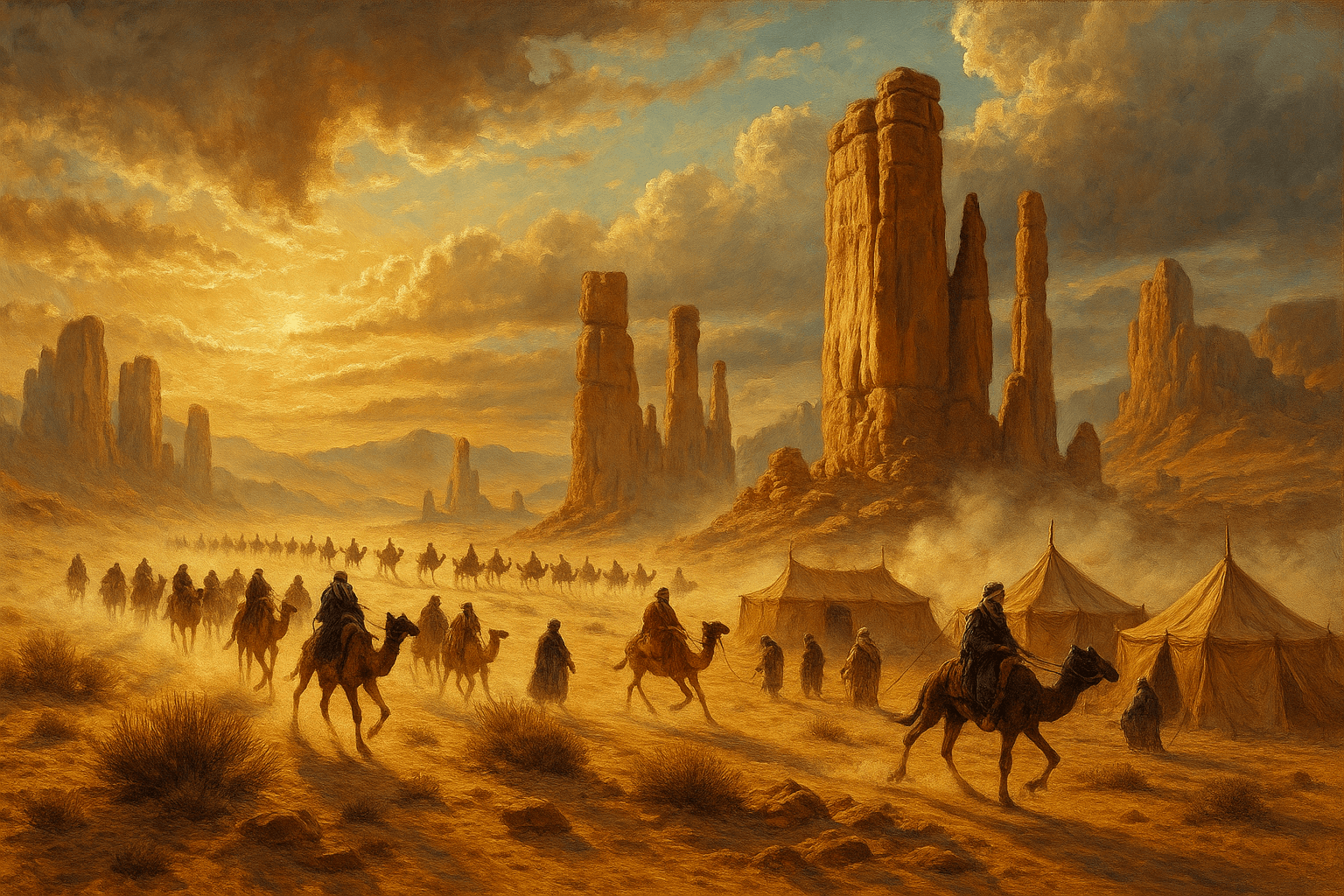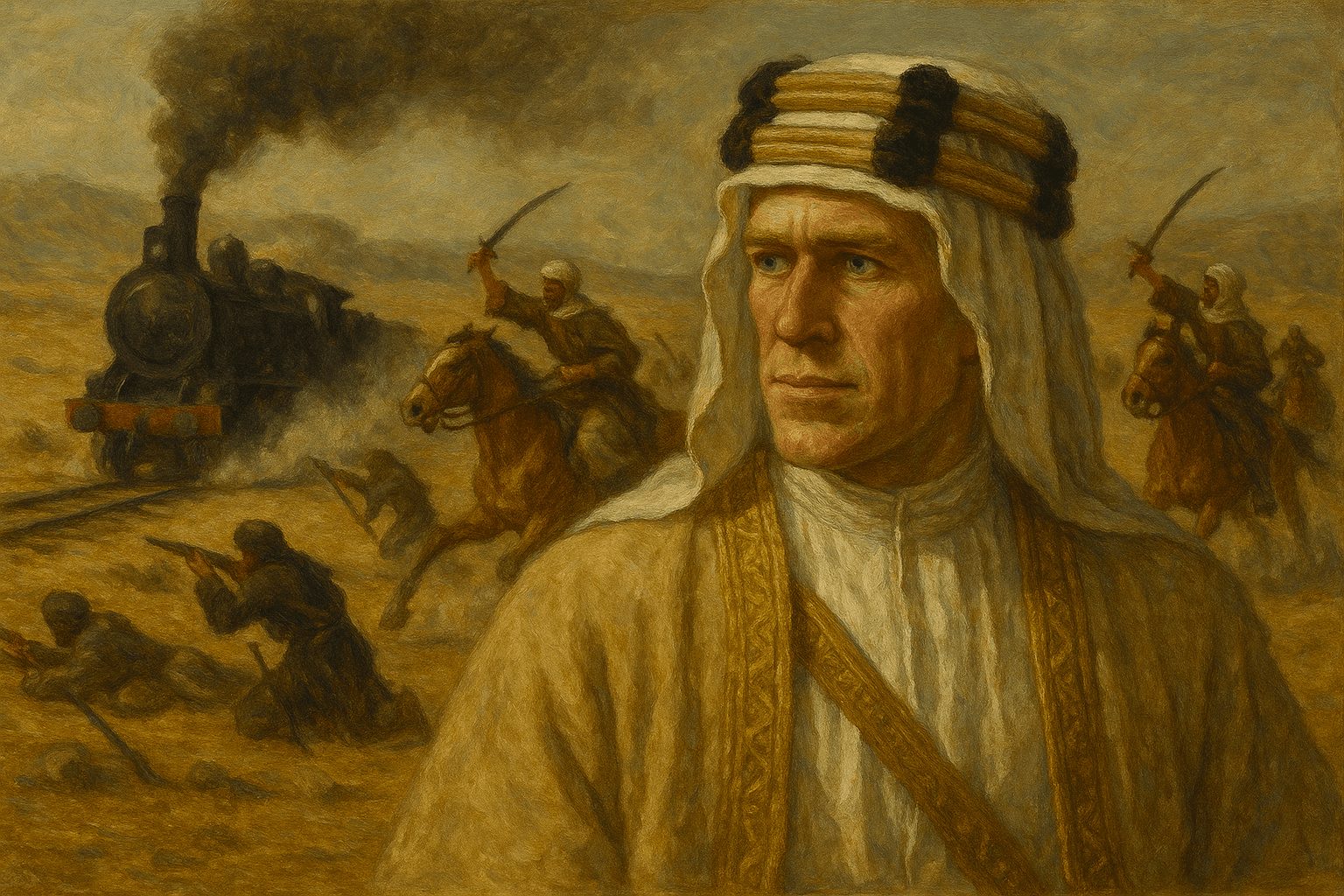T.E. Lawrence, celebrated as Lawrence of Arabia, transformed the art of irregular warfare. His campaigns during the Arab Revolt against the Ottoman Empire combined strategic brilliance with cultural sensitivity, changing the way modern militaries think and operate.
Operating in the harsh deserts of the Arabian Peninsula during World War I, Lawrence partnered with Bedouin tribes to challenge Ottoman control. His goal was not revolution but liberation. He sought to free Arab lands and unite tribes under a shared vision. Achieving this required more than military force—it demanded deep cultural understanding and the ability to inspire trust.
Lawrence’s most famous work, Seven Pillars of Wisdom, offers a detailed account of his experiences and tactics. He focused on undermining enemy morale rather than seeking conventional battlefield victories. His strategy included striking vulnerable supply lines, such as the Hejaz Railway, to cripple Ottoman logistics. By doing so, he forced them to divert resources and spread their forces thin.
He was skilled in psychological warfare, using surprise attacks and swift withdrawals to create uncertainty. Lawrence also used the desert itself as a weapon. Knowledge of terrain allowed his forces to move undetected and launch effective raids.
The lessons from his campaigns continue to shape modern conflicts, from Vietnam to Afghanistan. Both insurgents and counterinsurgents have adopted his principles, including mobility, cultural engagement, and political alignment.
Today, his strategies remain relevant. They demonstrate that in irregular warfare, success depends on adaptability, understanding the human environment, and combining military actions with political objectives.
Setting the Stage: Lawrence’s Historical Context
World War I provided the arena for Lawrence’s rise as a guerrilla strategist. Operating in the harsh deserts of the Arabian Peninsula, he aligned with Bedouin tribes to challenge the Ottoman Empire. Unlike many insurgents, Lawrence’s goals were political rather than revolutionary. He sought to liberate Arab lands and foster unity among tribes. This mission required more than military force—it demanded cultural understanding and the ability to inspire.
Lawrence’s writings, particularly Seven Pillars of Wisdom, offer profound insights into guerrilla tactics. He prioritized undermining the enemy’s morale over achieving direct military victories, which influenced later figures like Mao Zedong and Che Guevara. However, Lawrence’s pragmatism and respect for his allies’ autonomy set him apart.
Principles of Lawrence’s Irregular Warfare
1. Economy of Force
Lawrence recognized that smaller forces, when applied with precision and purpose, could achieve results far beyond their size. In Seven Pillars of Wisdom, he stresses that success in irregular warfare often depends on efficiency, agility, and strategic focus rather than sheer numbers.
Instead of confronting large Ottoman armies in costly battles, he targeted their logistical lifelines, knowing that disrupting supply chains could produce effects disproportionate to the effort. His most famous example was the campaign against the Hejaz Railway, the critical link supplying Ottoman bases across the desert.
By striking isolated sections of track, ambushing repair crews, and destroying bridges, Lawrence forced the Ottomans to divert troops and resources away from key fronts. These attacks slowed operations, eroded morale, and made nowhere along the line truly secure.
The Hejaz Railway raids embodied Lawrence’s belief in doing more with less by striking vulnerabilities rather than engaging in massed confrontations. His forces, often outnumbered and outgunned, created strategic impact by exploiting weaknesses in infrastructure, communications, and enemy confidence.
This approach aligns with modern strategic thinking. Military theorists such as John Boyd, creator of the “OODA Loop,” have echoed Lawrence’s emphasis on speed, adaptability, and maintaining the initiative. By acting faster than the enemy could respond, small units could keep larger, slower forces in a reactive posture.
Today, the principle of economy of force remains a cornerstone of both insurgent operations and counterinsurgency campaigns—proving that precision, timing, and efficiency can outweigh numerical or technological superiority.
2. Psychological Warfare
Lawrence understood that in irregular warfare, perception could be as decisive as physical force. He excelled at creating psychological uncertainty, keeping Ottoman forces off balance through unpredictable strikes and sudden disappearances into the vast desert. By avoiding fixed patterns, he denied the enemy the ability to anticipate his movements, forcing them to remain constantly alert and stretched thin across vulnerable positions.
These tactics amplified fear and eroded morale. To the Ottomans, Lawrence’s small, mobile force seemed omnipresent—capable of striking anywhere, at any time. This perception magnified their strength far beyond their actual numbers, a hallmark of effective guerrilla warfare.
Lawrence’s psychological strategy extended beyond battlefield maneuvers. He deliberately cultivated a legend around the Arab Revolt, portraying it as an unstoppable movement with wide tribal support. This narrative spread both among his allies and his enemies, influencing decision-making at all levels. For the Arabs, it reinforced unity and commitment to the cause. For the Ottomans, it fueled doubt and hesitation, undermining their will to fight.
His approach illustrates a fundamental truth of irregular conflict: shaping the enemy’s perception can be as important as inflicting physical damage. By controlling the narrative and projecting strength, Lawrence gained strategic advantages disproportionate to his actual resources.
This focus on psychological effects remains central in modern warfare, from counterinsurgency campaigns to information operations. Whether through media influence, disinformation, or precision strikes, the ability to affect enemy morale and public perception continues to define success in asymmetric conflicts.
3. Terrain as a Force Multiplier
For Lawrence, the Arabian desert was not an obstacle—it was a decisive ally. While conventional armies viewed its vast, barren expanse as hostile and unmanageable, the Bedouins understood its every nuance. They knew the locations of hidden water sources, the safest routes, and the skills needed to survive its extremes. This local knowledge transformed the environment into a powerful strategic asset.
Lawrence leveraged this advantage to outmaneuver and outlast the Ottoman forces. The desert’s vastness allowed his forces to move undetected, conceal their true intentions, and strike where least expected. Surprise attacks could be launched deep behind enemy lines, followed by rapid withdrawals into terrain that discouraged pursuit. Harsh conditions, which drained conventional troops, became a protective barrier for his fighters.
The principle of using terrain to offset disadvantages remains central to irregular warfare. Modern insurgent movements have adopted similar methods in vastly different environments. The Viet Cong turned the dense jungles of Vietnam into a defensive shield and staging ground. In Afghanistan, the mujahideen used mountainous terrain to frustrate both Soviet and NATO forces.
When properly understood and exploited, terrain can neutralize technological superiority and larger numbers. It allows smaller forces to dictate the terms of engagement, control the tempo of operations, and impose disproportionate costs on the enemy. Lawrence’s campaigns in the Arabian desert remain a textbook example of how environmental mastery can redefine the balance of power in asymmetric conflict.
4. Integration of Political and Military Goals
For Lawrence, military success could never be separated from political purpose. His ultimate objective during the Arab Revolt was not simply defeating Ottoman forces—it was fostering Arab unity and securing independence. Every raid, ambush, and strategic move was designed to support this larger vision, ensuring that battlefield victories translated into lasting political gains.
A key to his success was aligning military operations with the goals of the tribes he worked alongside. By respecting their autonomy, honoring cultural traditions, and recognizing their political goals, Lawrence built trust and loyalty that endured through hardship. This mutual respect made cooperation possible even among diverse and sometimes rival tribal factions.
His approach mirrors modern counterinsurgency doctrine, such as the principles found in the U.S. Army’s Field Manual 3-24. In irregular warfare, winning requires more than destroying enemy forces—it demands building a legitimate and sustainable political future. Without this, military gains can collapse once fighting ends.
Lawrence demonstrated that political alignment strengthens military effectiveness, while ignoring it risks alienating allies and undermining long-term objectives. This integration of strategy remains vital in contemporary operations, from coalition building in counterinsurgency campaigns to stabilization efforts in post-conflict environments.
By combining military precision with political foresight, Lawrence ensured that his campaigns served both immediate tactical needs and enduring strategic aims. His legacy shows that in irregular warfare, the battle for legitimacy is as critical as the fight for territory.
Lawrence’s Impact on Modern Warfare

Lawrence’s principles have profoundly shaped modern military doctrine. The U.S. military, for example, integrated many of his ideas into its counterinsurgency practices. Cultural understanding, population-centric strategies, and psychological operations all reflect his influence.
Applications in Contemporary Conflicts
The Vietnam War saw guerrilla tactics reminiscent of Lawrence’s campaigns. The Viet Cong used mobility and terrain to frustrate U.S. forces, avoiding direct confrontations while targeting supply lines. Similarly, in Afghanistan, both Soviet and NATO forces faced insurgents who leveraged local geography and community networks.
Counterinsurgents have also adopted Lawrence’s lessons. The “Sunni Awakening” during the Iraq War, where U.S. forces collaborated with tribal leaders, echoes Lawrence’s emphasis on local autonomy and culture.
Lessons for Today’s Leaders
1. Understand Local Context
Lawrence’s deep engagement with Arab culture allowed him to tailor strategies to his allies’ needs. He worked within their tribal structures, earning trust and fostering cooperation. Because of this, his plans matched local realities and gained stronger support. Modern military leaders must similarly prioritize cultural intelligence to succeed in complex environments today.
2. Prioritize Psychological Advantage
Undermining enemy morale remains as crucial today as in Lawrence’s time. Creating uncertainty, leveraging perception, and inspiring allies can quickly shift momentum. Because of this, such psychological advantages often decide outcomes in asymmetric conflicts, even when military strength alone is not enough.
3. Balance Independence and Support
Lawrence ensured that Arab forces kept their autonomy, even while using British resources. Modern insurgencies and counterinsurgencies face similar challenges. Overreliance on outside aid can weaken legitimacy, while complete independence may reduce effectiveness. Therefore, striking the right balance is critical for sustaining both operational success and political strength over time.
The Broader Implications of Lawrence’s Philosophy
Lawrence’s strategies reach far beyond the battlefield and remain highly relevant today. His emphasis on aligning military actions with clear political outcomes offers lessons for leaders in military, political, and organizational contexts. Success in complex systems depends on adaptability, cultural sensitivity, and a coherent strategic vision that links tactical actions to long-term goals. These principles are vital not only for irregular warfare but also for diplomacy, crisis management, and coalition-building.
The Power of Influence
Lawrence understood that controlling physical territory was often less important than shaping how people think and feel. He focused on creating zones of influence, where loyalty, perception, and alliances mattered more than geographic boundaries. This approach is just as relevant in modern conflicts, where information warfare, strategic communications, and psychological operations can decide the outcome of campaigns. By influencing beliefs and perceptions, leaders can shift the balance of power without large-scale battles, conserving resources while achieving strategic effects.
The Role of Myth and Narrative
Lawrence’s skill in creating a compelling narrative around the Arab Revolt amplified its strategic impact. He transformed military actions into a powerful story that inspired unity, resilience, and international attention. This myth-building magnified the revolt’s significance and helped sustain morale among diverse tribal factions. Modern military and political leaders can learn from his use of storytelling to inspire, shape public opinion, and build legitimacy. In an era of global media, narrative power is often as critical as military strength in shaping strategic outcomes.
The Timeless Legacy of T.E. Lawrence

T.E. Lawrence’s contributions to irregular warfare extend beyond his time in the Arabian Desert. His insights into terrain, psychology, and the integration of military and political goals remain essential for understanding modern conflicts. From guerrilla fighters to counterinsurgents, leaders continue to draw on his wisdom.
As warfare evolves, the principles Lawrence championed—adaptability, cultural understanding, and strategic alignment—continue to offer enduring guidance. His campaigns remind us that victory often hinges not on sheer force but on the ability to inspire, adapt, and outthink the enemy.
Why Study T.E. Lawrence
The lessons of T.E. Lawrence remain highly relevant in today’s world, where asymmetric and irregular conflicts dominate the global security landscape. Studying his life and strategies provides both historical insight and practical tools for addressing contemporary and future challenges. His ideas continue to influence military professionals, political leaders, and scholars worldwide.
Seven Pillars of Wisdom is both a historical account and a deeply personal reflection on Lawrence’s role in the Arab Revolt during World War I. The work explores leadership, military strategy, cultural understanding, and personal transformation, offering perspectives that extend beyond the battlefield.
The Arab Revolt (1916–1918) was a critical uprising against the Ottoman Empire, supported by Britain to weaken a common enemy. Serving as a British officer, Lawrence worked closely with Arab forces led by Prince Faisal and Sherif Hussein. His narrative blends personal experiences with significant historical events, giving readers a vivid understanding of the revolt’s military operations, political dimensions, and cultural dynamics.
Through Seven Pillars of Wisdom, readers not only learn about the Arab Revolt’s military campaigns but also gain an appreciation for the complexities of coalition warfare, the importance of cultural adaptation, and the enduring tension between political promises and strategic realities.
Arab Revolt and the Context of World War I
In Seven Pillars of Wisdom, Lawrence details the strategic motives behind British support for the Arab Revolt. Britain sought to weaken the Ottoman Empire by offering Arab independence in return for military cooperation. These promises aimed to secure crucial allies in a difficult and strategically important theater of World War I.
Lawrence, however, was deeply troubled by the dishonesty behind these commitments. He knew of the secret Sykes-Picot Agreement, which divided the Middle East between Britain and France, directly contradicting the independence pledges. This betrayal appears repeatedly in his writing, highlighting the tension between imperial ambitions and genuine self-determination.
The episode underscores a central theme in Lawrence’s story—the conflict between wartime strategy and moral responsibility. It also reveals the essential role of trust in coalition warfare. When political duplicity enters the equation, even the most effective military campaigns risk collapse. This historical context continues to hold relevance for understanding both irregular warfare and the complex geopolitics of the modern Middle East.
Guerrilla Warfare and Military Strategy Used by Lawrence
One of the most well-known sections of Seven Pillars of Wisdom focuses on Lawrence’s mastery of guerrilla warfare. His strategy relied on speed, surprise, and psychological tactics instead of traditional set-piece battles. He believed small, fast-moving groups could outmaneuver and exhaust larger, more organized armies through relentless unpredictability.
These units targeted vital supplies, sabotaged transportation routes, and attacked isolated outposts. By avoiding direct confrontations, they denied the enemy decisive victories. This forced opponents to stretch their resources and remain on constant alert, amplifying fatigue and uncertainty.
Lawrence’s approach demonstrated that flexibility, creativity, and adaptability are essential in irregular warfare. His campaigns against the Ottoman Empire proved that disrupting logistics and morale could be more decisive than capturing territory. The emphasis on mobility, timing, and psychological advantage remains a core principle in modern insurgency and counterinsurgency operations.
Key principles of Lawrence’s guerrilla strategy include:
- Hitting Soft Targets: Rather than engaging Ottoman forces head-on, Lawrence’s forces focused on disrupting supply lines, sabotaging railways, and attacking isolated garrisons. This strategy weakened the enemy’s ability to project power over vast desert territories.
- Leveraging Geography: Lawrence understood the importance of the desert’s harsh environment, using it as a natural advantage and using the desert’s vastness and inhospitable conditions to provide a defensive advantage, deterring pursuit and confusing the enemy.
- Psychological Warfare: The Arab forces’ unpredictability created a constant sense of insecurity among Ottoman troops. Lawrence emphasized the psychological toll of warfare, arguing that the fear of attack often achieved more than the attacks themselves.
- Unity Through Leadership: Lawrence recognized the need to align disparate tribal factions under a common cause. His ability to adapt his leadership style to Arab customs and traditions was crucial in maintaining cohesion among the revolt’s participants.
Cultural Understanding and Adaptation According to Lawrence
Lawrence’s deep immersion in Arab culture is a defining feature of his narrative. He adopted local dress, customs, and language, earning the trust and respect of his Arab counterparts. This cultural sensitivity allowed him to bridge the gap between British strategic goals and Arab aspirations, creating a foundation for genuine cooperation.
Seven Pillars of Wisdom emphasizes the vital role of cultural understanding in leadership, diplomacy, and irregular warfare. Lawrence’s success was rooted in his ability to empathize with Arab grievances, aspirations, and traditions, shaping strategies that aligned with local values. By respecting tribal autonomy and recognizing cultural identity, he strengthened alliances that endured under pressure.
However, he also accepted the limits of his influence. Tribal rivalries, shifting loyalties, and different visions for the revolt’s ultimate goal often complicated his mission. These realities show a timeless lesson: cultural understanding must pair with adaptability, patience, and awareness that not all objectives align.
The Role of Leadership and Individual Agency
Leadership is a central theme throughout Seven Pillars of Wisdom, and Lawrence offers a candid view of its complexities. He reflects on his role as a leader, often confronting moral ambiguities and the tension between strategic necessity and ethical responsibility. For Lawrence, effective leadership meant guiding others while allowing them to retain their agency and dignity.
This philosophy is most evident in his collaborative relationship with Arab leaders like Prince Faisal, whom he portrayed as the revolt’s rightful figurehead. By deferring to the local authority, Lawrence strengthened legitimacy and trust among his allies. Yet his account also reveals personal doubts and insecurities, exposing the internal struggles of a leader balancing competing loyalties.
He wrestled with the ethical implications of using Arab forces to advance British objectives, questioning whether his actions truly supported Arab independence. This self-awareness deepens the historical value of his work, illustrating that leadership in irregular warfare is as much about moral judgment as it is about tactical skill.
The Power of Myth and Narrative
Lawrence infused his storytelling with a deliberate sense of myth, framing the Arab Revolt as a heroic and unifying struggle. He elevated its participants to near-legendary status, ensuring their deeds would inspire far beyond the immediate conflict. At the same time, he recognized the gap between myth and reality, openly acknowledging the revolt’s contradictions, rivalries, and imperfections.
This dual awareness adds depth to his work, showing that even powerful narratives must be understood in their full complexity. It underscores the role of myth in shaping historical memory and influencing both contemporary and future perceptions. Lawrence’s skill in weaving compelling stories not only cemented his own legacy but also shaped how the Arab Revolt is remembered and studied. His approach demonstrates that in both warfare and politics, the story told can be as influential as the events themselves.
Conclusion
T.E. Lawrence’s Seven Pillars of Wisdom remains a cornerstone for understanding irregular warfare, strategy, and leadership. Its principles—ranging from guerrilla tactics to deep cultural engagement—offer practical lessons for navigating modern conflicts and political challenges. Lawrence demonstrated that success in irregular warfare requires adaptability, psychological insight, and alignment between military action and political objectives.
The accompanying works recommended in this study expand on those ideas, offering diverse perspectives on resistance, insurgency, and counterinsurgency in different historical and regional settings. Together, these texts provide a layered understanding of both the theory and practice of irregular conflict.
Lawrence’s insights continue to influence military planners, political leaders, and scholars. They highlight the enduring challenges of warfare, the complexities of leadership in culturally diverse environments, and the necessity of integrating strategy with moral purpose. In a rapidly changing geopolitical world, his lessons remain as relevant as ever.
DISCLAIMER: Links included might be affiliate links. If you purchase a product or service with the links that I provide I may receive a small commission. There is no additional charge to you.





Leave a Reply